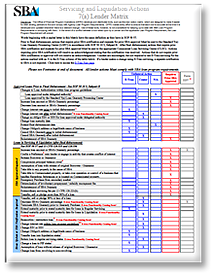
LendXP receives numerous servicing questions from participant lenders. The inquiries often relate to specific instances, but the underlying questions are similar in nature:
- What actions can a Lender take on an SBA loan without jeopardizing the SBA guaranty?
- Does the Lender need SBA’s approval for a specific servicing action, and if so, how is the approval obtained?
- Can the Lender take action without SBA’s approval and if so, what are SBA’s requirements for documenting the action?
These questions, and many others, can be answered with the help of the Small Business Administration’s Lender Matrix.
The SBA has published the “Servicing and Liquidation Actions 7(a) Lender Matrix.” The current version was issued on April 30, 2013. (See the SBA Lender Matrix, Version 9 below.) The Matrix categorizes servicing actions into three major buckets:
-
SBA Approval Required
-
SBA Notification Required
-
Lender’s Unilateral Actions
A majority of the questions LendXP answers for its lenders fall into the first bucket in the Lender Matrix: SBA Approval Required. These are actions that require SBA’s prior approval before the Lender has authority to take the action. These actions include increasing the loan amount or the SBA guaranty percentage; transfer, sale or pledge of more than 90% of an SBA loan; and reinstatement of SBA’s guaranty.
The servicing actions that require SBA’s prior approval and sometimes create confusion for SBA Lenders are “release of borrower or guarantor”; “determination of involuntary prepayment/subsidy recoupment fee”; and “confer a preference onto Lender or engage in activity that creates conflict of interest.” These last three actions can be considered three cardinal rules of servicing an SBA loan.
SBA Servicing Cardinal Rule Number 1
Never release a borrower or guarantor without SBA’s express written approval. Whereas a Lender can release collateral without SBA’s prior approval, the Lender must always seek SBA’s permission to release a borrower or a guarantor of an SBA loan. The formal process to release a borrower or guarantor is called an “Offer in Compromise.” SBA has issued guidance in SOP 50-57 Chapter 18 entitled Offers in Compromise. To process a release of a borrower or guarantor, the entity must submit a written offer (SBA Form 1150) and a current financial statement (SBA Form 770) as well as tax returns and other financial information. Several factors influence the acceptance of an Offer in Compromise, but before releasing an entity on an SBA loan ALWAYS get SBA’s prior written approval.
SBA Servicing Cardinal Rule Number 2
Never waive a subsidy recoupment fee for a borrower unless SBA has made a formal determination that the loan repayment was involuntary. Loans with a maturity of 15 years or longer require a Subsidy Recoupment Fee to be included when the borrower voluntarily prepays more than 25% of the outstanding principal balance. In the first year of the loan, a voluntary prepayment of 25% or more requires an additional payment of 5% of the total prepayment amount. In the second year, a voluntary prepayment requires an additional payment of 3% of the total prepayment amount. In the third year, a voluntary prepayment requires an additional payment of 1% of the total prepayment amount. There is an exception to that rule: If the prepayment on the loan is deemed involuntary, the fee is not required. Any request to waive the Subsidy Recoupment Fee requires a formal request to SBA along with the delineated reasons for the involuntary prepayment.
SBA Servicing Cardinal Rule Number 3
Never engage in preferential treatment or create a conflict of interest between the SBA loan and the Lender’s interest. What does this mean? For example, the SBA loan has a first lien on accounts receivables and inventory and the participant bank wants a first lien on accounts receivable and inventory to fund a $100,000 operating line. This is a Lender Preference because it benefits the Lender over the SBA loan. It may still be a good solution to the borrower’s operating needs and with proper justification, SBA may consider subordination of the first lien on accounts receivables and inventory to the lender’s outside debt — but it requires SBA’s review and prior approval.
Knowing these three fundamental rules and utilizing the guidance provided in SBA’s Lender Matrix can help participant lenders take action without jeopardizing an SBA guaranty. If you have an SBA servicing question, we can answer it! We will consult on simple or complex servicing questions to determine the proper action to take with regards to the requirements of the Small Business Administration.
To download the SBA Lender Matrix, Version 9, click on this link or on the image to the left.
